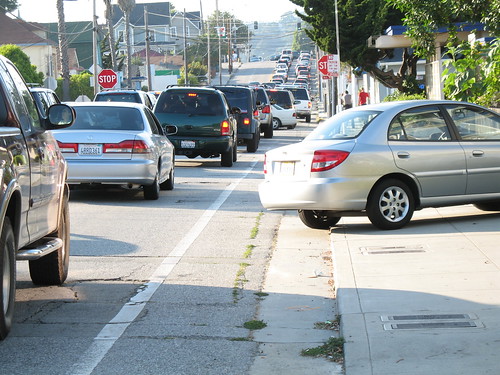The city of Santa Cruz, California can see its population of 60,000 people double on a nice summer weekend. Tens of thousands of cars clog the local streets as visitors search for parking before hitting the beaches, the Boardwalk, and other tourist venues around the County.

While many locals see troublesome traffic congestion, businesses see dollar signs inside of each car and truck that rolls into town from Highway 17.
When government works to discourage driving, can businesses that depend on tourist traffic find a way to survive?
The Oregon Transportation Research and Education Consortium (OTREC) asked this question to see if there’s a correlation. Transportation planners have always observed that vehicles miles traveled (VMT) always rises with increased economic activity, and falls with less economic activity. Some have suggested that VMT increases economic activity — in other words, more driving automagically leads to more economic activity.
The OCTREC study, however, shows VMT goes up as a result of economic activity, not the other way around. When economic activity declines during recession, it’s not because people drive less. People drive less because there’s less economic activity. When government in large cities enact programs to discourage driving, OCTREC found economic activity continues unhindered.
Elly Blue notes that you can’t just reduce driving miles — you also need to provide for other modes of transportation.
How do you transport 60,000 people from the Bay Area to the beaches? Back before the state of California built a highway over the Santa Cruz Mountains at public expense, private rail once delivered tourists from San Jose and Los Gatos straight to the Santa Cruz Beach Boardwalk. Southern Pacific filed to abandon their Los Gatos rail line in 1940, immediately after State Route 17 opened, and 16 miles of property tax revenue generating right-of-way was replaced with a “free” highway. The city of Santa Cruz and private businesses covered acrage with new parking lots to accommodate visitors using the new highway.
Alternative transportation for the trip to Santa Cruz has its issues — the auto trip via Highway 17 takes about 20 minutes from Los Gatos to Ocean Street, while the train journey took over an hour and a half. Bus capacity is limited. Encouraging bike travel “over the hill” is unrealistic for most people.
Transportation debate in Santa Cruz occurs between those who would like to eliminate all new road and parking construction, those who commute from the south county along Highway 1, and those depend on the tourist trade and generally would like to improve auto flow into Santa Cruz.
Still, there are possibilities to reduce VMT in Santa Cruz without reducing tourist travel. The Downtown Association runs a beach trolley between downtown and Main Beach to reduce the number of people driving between downtown and the beaches. A ton of people load their bikes on the car, drive over the mountains, then bike to get around town. The city is investigating the possibility of an excursion rail line along the coast that could reduce traffic on Highway 1 while bringing more tourist business.
There’s also the Roaring Camp railroad, where people park in Felton then take the tourist train to the Boardwalk. You can take the 10:15 train to Felton, arrive at the Boardwalk ahem a full hour later, then take the 4:15 PM train back to Felton. (Exclusive of special bike events, note that this is a premium priced tourist train meant more for entertainment than transportation. It’s $10 to park next to the Boardwalk, vs $8 parking at the railroad plus $26 for your round trip train ticket).
Okay, the tourist trade is a horrible example, but remember: tourist traffic to Santa Cruz predates widespread use of the automobile, and it will likely continue in some form after we’ve depleted our planet’s supply of cheap fuel.